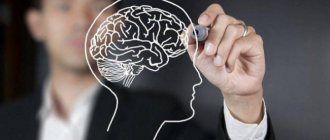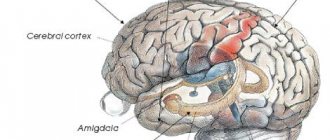Nikolay Frantsuzov, neuropsychologist and researcher at Vikium, spoke especially for Netology about memory problems and ways to develop it in people of different professions: designers, marketers, analysts.
It is known that temporary neural connections that are formed in the cerebral cortex can persist for many years and decades. If they are reinforced from time to time or renewed, these communications are preserved forever.
Training program: “Big Data: basics of working with large amounts of data”
A person is under the influence of various harmful factors that have a negative impact. This leads to a decrease in mental and creative activity, especially in professional activities. First, memory functions decline. It becomes more difficult to recall significant information, remember large volumes of new material, repeatedly reproduce what you already know, and operate with the knowledge available to us. It all ends with a lack of flexibility of thinking and creativity.
A little about the structure of memory
The simplest memory test: close your eyes and tell what is where in the room. Or recite a poem.
All these are different cases of reproducing this or that information, restoring, detecting previously formed temporary neural connections.
The implementation of memory involves multiple structures of the brain, which have a strict organization and patterns. Subcortical structures (basal sections, medulla oblongata and brainstem) are involved in the processes of short-term memorization or memory for current events, activity of consciousness and attention. And the cortical parts of both hemispheres of the brain take part in the processes of visual, auditory-verbal, musical, tactile, and motor memory. This is an extensive occipital and inferior parietal region, temporal and part of the frontal regions.
No less important are the mediobasal and prefrontal areas of the forehead, which are responsible for the regulation of mental activity and control over its course. They are responsible for the conscious organization of memory, its meaning-forming component, verbal-logical form and arbitrariness. The intersection of the temporal, inferior parietal and occipital areas (zone TPO) are responsible for the spatial organization of mnestic traces, the creation of connecting visual images and ideas, and the creation of semantic concepts (long-term memory).
During intentional memorization, the work begins in the frontal regions, after the organization of mnestic traces in the TPO zone (here the formation of multiple neural connections occurs) and then the frontal regions again participate in the reproduction processes. This is how horizontal organization occurs at the physiological level. It is also necessary to take into account the vertical organization: the participation of subcortical structures in connections with the cerebral cortex.
Types of memory
Memory is spoken of as an extremely complex cognitive function. Many parts of the brain take part in its work, and it is used constantly.
In the book “General Fundamentals of Psychology,” Doctor of Psychological Sciences, academician and corresponding member of the Academy of Pedagogical and Social Sciences and the International Academy of Psychological Sciences R. S. Nemov classifies memory (defines types) according to a number of criteria.
The nature of mental activity
According to this criterion, memory is:
- motor (motor);
- emotional;
- figurative;
- verbal-logical.
Motor memory is the ability to remember, store and reproduce various movements. With its help, various practical and work skills are formed (walking, writing).
Emotional memory captures experienced feelings and emotional states in the form of ideas. Usually, what is associated with emotional experiences is remembered easily and for a long time. This type of memory is important for human motivation.
Figurative memory is associated with the ability to store and use images of perception. The specificity of the captured image is determined by the characteristics of a person’s perception and the work of his system of analyzers.
The verbal-logical type of memory is necessary for memorizing and reproducing thoughts.
Nature of activity goals
Types of memory: Freepick
This criterion is also called the arbitrariness criterion. According to it, memory is divided into:
- Involuntary. When the processes of memorization and reproduction are carried out automatically, without a person’s volitional effort and consciousness control.
- Free. This type of memory is characterized by memorization and reproduction, which requires effort of will.
Duration of information storage
According to this classification, memory is divided into:
- short-term;
- operational;
- long-term
Short-term memory is an intermediate “storage” of data. This type of memorization is associated with a single or very short perception.
Working memory is associated with remembering and reproducing information that is necessary to carry out a specific current activity. After solving the problem, the information may disappear completely.
This happens with material that students study immediately before an exam. This type of memory is transitional from short-term to long-term memory.
Long-term memory stores the entire volume of a person's knowledge and experience. The more often information from it is reproduced, the more firmly it is fixed.
Nature of information acquisition
Memory can be genetic or lifetime. The first preserves species-specific information, and the second preserves a person’s individual experience.
Genetic memory is a tendency to certain behaviors and actions that have developed and become established in a species evolutionarily. For example, the fear of falling and a reflexive reaction to a falling object (bounce away, look back at the noise) is a manifestation of genetic memory. All information that a person learns after birth is classified as intravital memory.
Memorization method
Mechanical and semantic memory are distinguished. Rote memorization occurs through simple repetition. Semantic memory requires associative and semantic connections.
The halls of human memory store enormous amounts of information. Some of it is gradually forgotten, which is natural and necessary for the proper functioning of the brain. Fortunately, memory can be worked on and improved.
Original article: https://www.nur.kz/family/self-realization/1759275-pamat-psihologia-interesnye-fakty/
Fighting Forgetting
Not everything that we once remember (intentionally or not) is retained in our memory forever. We forget a lot, which is why we often become unsuccessful, especially in our profession.
Forgetting is a long-term process that develops gradually.
And to successfully combat it, it is necessary to take into account the following provisions:
- The main means of struggle is repetition of the material being studied. Any knowledge that is not reinforced by repetition is gradually forgotten.
- You need to repeat what you have learned not when it has already been forgotten, but at the moment before forgetting has yet begun.
- When moving from memorizing material to memorizing another, you should always take a short break (5-10 minutes), giving yourself a complete rest from all mental work at this time.
- Systematicity is necessary, you need to organize your classes so that the materials you remember are on less similar subjects. A distinction is necessary so that similar themes do not overlap each other, so that difficulties do not arise in recalling specific images.
- It is useful to recall especially important, responsible and difficult material in your memory immediately before going to bed: it is sleep that provides the most favorable conditions for consolidating the results of memorization.
Memory concept
Memory is a mental process that is expressed in a person’s ability to retain past experiences, as well as the ability to reuse them in their life and work. Memory is a trace that mentally reflects the past. It makes it possible to connect the past, present and future in a single process. Thanks to memory, a person absorbs the experience of previous generations and acquires new knowledge, skills and abilities.
People use memory all the time. It plays a big role in preserving individual, personal and business characteristics. A person who is completely deprived of the ability to record, store, study and reproduce his past experiences actually ceases to be a person. Memory is considered as a special process, which gives it the role of a specific “integrator” of all other mental cognitive processes. Thus, memory is a cumulative mental reflection of a person’s past interaction with reality, the information fund of his life. Memory is the process of organizing and preserving past experiences by a person, which allows them to be repeatedly used in activities.
Memory education for specialists in their field
Every person would like to have a better memory. This is a completely natural desire, but to realize it you need to be clear about what a good memory is. Having an exceptionally strong capacity for rote learning is not in itself a very valuable attribute. Psychological analysis shows that the biographies of many outstanding people note their remarkable memory, and the whole point is not in the abilities of mechanical memorization, but in the exceptional development of semantic memorization. What determines its development?
What a person’s mental life is directed towards, what its interests are. Semantic memorization is characterized by the fact that a person remembers information that is essential and necessary for him, what is interesting to him. The wider, more varied and more meaningful a person’s interests are, the richer and more meaningful the “reserves” of his memory will be. A person's memory depends on what he is interested in.
The development of memory directly depends on the mental development of a person. Anyone who has great and varied knowledge will easily find many semantic connections for the new material that he needs to remember. The more knowledge a person has, the better his memory becomes in relevant areas.
Consistency and organization in memorization is the most important condition in the development of memory. It is necessary to strive for a system of knowledge, and not for a simple accumulation of facts.
There are a number of methods that can be used as daily training methods to strengthen and develop memory function. Most of them are applicable in everyday life and meet the needs of various specialists.
for designers and developers to develop visual images and representations that organize the memory function. To do this, you can perform a simple exercise. Exclude one or more cognitive senses from use for a while. Try eating blindfolded, showering with your eyes closed, or covering your ears while doing normal activities.
Such an exception will contribute not only to the development of other cognitive functions and the consolidation of already created working neural connections, but also to the formation of imagery of what is happening. Building logic between these images will have a beneficial effect on the development of visual-figurative thinking.
An excellent method would be to develop the functions of both hands equally.
That is, use your non-dominant hand in various activities. For example: brush your teeth in the morning, comb your hair, or use a computer mouse. Try writing a short text with both hands at the same time or swapping your knife and fork while eating. This method promotes the development of neural connections in new areas and activation of the brain.
As Gary Spall assures: “shopping is an excellent training for memory,” while shopping, a person interacts with new people, pays attention to their faces, constantly activates the attention function, and calculates prices. Performs all those actions that make different areas of the brain work, and at the same time they follow each other.
For analysts and marketers , the ability to think systematically and systematically organize your memory will be useful. To do this, you need to train observation skills. For example, throughout the day, pay attention only to the color green or to a car of a certain model from the general stream, come up with a theme and focus on it. Thus, you will develop certain properties of the attention and memory function: concentration, selectivity, distribution, switching, short-term memorization.
Read and write down as much as possible.
After you have read or learned something, try to write it down at least once. Writing it down once is like reading it twice and organizing everything in your head.
Make the material you are supposed to learn in an accessible and convenient format for you. If you find it easier to remember using visual memory, then organize the necessary material in graphic form.
The systematic organization of all the information that you are trying to remember is important. Write down the necessary facts and establish semantic connections between them, remembering which you will see the whole picture.
What is memory and what are its capabilities?
Memory is the process of storing and subsequently reproducing an individual's experience. In psychology, memory has been studied for a long time and is interpreted in different ways:
- The associationist theory considered association (connection, connection) to be the main unit of memory. The mechanical addition of associations should become the basis of memory. In the future, it is rethought and deepened.
- Behaviorism viewed memory as a process through which various motor and language skills are acquired.
- Gestalt psychology studied the processes of remembering, focusing on the intention of the subject. This scientific direction studies the social nature of human memory.
At the present stage, memory is considered as a cognitive process, which is characterized by the following properties:
- Volume. It shows the ability to memorize and retain information.
- Speed of memorization (speed of voluntary memorization).
- Readiness to reproduce (how well a person applies available information).
- Reproduction accuracy (the quality of storing and reproducing information).
- Duration of retention (the ability to retain the necessary information for a certain time).
What are the capabilities of our memory? Memory can be trained to remember more. But don’t think that forgetting is the result of faulty memory, emphasizes psychologist and researcher from the University of California Benjamin Storm. Forgetting ensures the proper functioning of memory and thinking, freeing up resources for new tasks.
Neuroscientist Maria Wimber from the University of Birmingham (UK) and colleagues, using a special brain scan, found that memories can “compete” with each other for memory resources. This mechanism helps to select the desired memories from a number of similar ones.
Memory Properties: Freepick
Scientists are also researching what to do to improve memory performance and expand its capabilities. They have established a number of techniques that help activate human memory.
The memory must be turned on
When people do not wait to check that they have learned information, they forget it very quickly. Human cognitive researcher Professor Brad Wyble has found that when people don't expect to be tested, they often don't remember anything. However, when it comes to testing, memorization is two or even three times better.
Classical music improves memory
Listening to classical music increases the activity of genes that are associated with memory and learning processes, and at the same time reduces the activity of genes that affect neurodegenerative processes. Research by a group of authors has shown that classical music actively influences the human genome.
Daytime naps improve memory fivefold
The experiment showed that a daytime nap that lasts less than an hour improves memory performance fivefold. Two groups of subjects memorized pairs of unrelated words. Then the first group slept for 45-60 minutes, and the second watched the video. After testing, it turned out that in the first group the level of memorization was higher.
Scientists have yet to discover the subtle mechanisms of memory. However, what we know today can and should be used to expand our own capabilities.
Conclusion
Something is constantly happening in our lives, we are often in a hurry and have to do everything without forgetting anything. Under such conditions, we have difficulty focusing our attention and remembering, but even greater difficulties arise in learning effective ways to remember. Therefore, we recommend that you use the suggested methods and tips on how to develop your memory.
The opinions of the author and the editor may not coincide. Would you like to write a column for Netology? Read our terms of publication.
Introduction
Psychology is the science of the human psyche, studying the patterns of mental phenomena.
All mental phenomena are conventionally divided into three groups: mental properties, mental states and mental processes [2; 3; 5]. These groups of mental phenomena differ from each other, first of all, in their duration and stability in a person’s mental life. Mental processes function directly at a given current moment in time, mental properties are the most stable psychological characteristics of a person, and mental states are short-term and occupy an intermediate position between mental processes and mental properties.
All mental processes , in turn, can be divided into cognitive, emotional and volitional [2; 3]. Cognitive mental processes include mental processes associated with the perception and processing of information. These include perception, memory, thinking, attention, etc. The functioning of cognitive mental processes allows a person to receive information about the world around him and operate with it in his consciousness. Emotional mental processes are associated with a person’s needs: information coming from cognitive mental processes, depending on the correspondence or non-compliance with his needs and desires, becomes significant or not significant for a person, causing mental processes such as affects, feelings, emotions, etc. . They determine a person’s attitude to individual phenomena of the surrounding reality. In conditions of the need to make decisions and overcome difficulties, volitional mental processes appear that are associated with a person’s conscious regulation of his behavior.
This test is devoted to the study of one of the cognitive mental processes of a person - the study of memory.
Bibliography
- Bukhanovsky A.O., Kutyavin Yu.A., Litvak M.E. General psychopathology: A manual for doctors. – 2nd ed., revised. and additional – Rostov n/d.: Publishing house LRRC “Phoenix”, 2000. – 416 p.
- Clinical psychology: Textbook. 3rd ed. / Ed. B.D. Karvasarsky. – St. Petersburg: Peter, 2007. – 960 p. (National Library of Medicine Series).
- Maklakov A.G. General psychology. – St. Petersburg: Peter, 2002. – 592 p. – (Series “Textbook of the New Century”).
- Medical psychology: the latest reference book for a practical psychologist / comp. S.L. Solovyova. – M.: AST; St. Petersburg: Sova, 2006. – 575 p.
- Nemov R.S. Psychology: Textbook. for higher education students ped. textbook establishments: In 3 books. Book 1. General fundamentals of psychology. – 3rd ed. – M.: Humanite. ed. VLADOS center, 1997. – 688 p.
- Rubinshtein S.L. Fundamentals of general psychology. – St. Petersburg: Peter Kom, 1999. – 720 p. – (Series “Masters of Psychology”).
- Shapar V.B., Timchenko A.V., Shvydchenko V.N. Practical psychology. Tools. – Rostov n/d: publishing house “Phoenix”, 2002. – 688 p.
How to make a lasting impression
A person's impressions of remembered information have 2 useful properties that help our memory. Firstly, interest in the object of memorization makes us more attentive, and secondly, emotions help to better consolidate the object in our long-term memory.
Below are several principles that you can use to increase the importance of emotional perception in remembering information. These principles will help you create a strong, vivid first impression of the object of memory and retain it in your memory.
- First impression. It is useful to create a first emotional impression of a memorized object, and to record it in memory as accurately as possible.
- Visual image. First of all, try to get a visual impression as it is stronger. The nerves leading from the eye to the brain are twenty times thicker than the nerves leading from the ear to the brain.
- Great impression. If possible, in addition to visual perception, try to receive impressions using as many senses as possible, which will help you experience it more strongly.
- Play again. Try to revive in your memory the first impression of the memorized object more often. It is better to be under the first impression and not try to get a new one.
- Find similar. While reproducing your first impression of an object, think about what that impression is like and whether you have experienced something similar before.
In addition to these principles, you can also use special techniques for organizing the process of memorizing information. These techniques allow you to enhance emotional impact and awaken interest in the material being studied.
Games. Try to always find something interesting in your routine, turning any action into a game. This is what good parents do who want their child to do some boring work. Games are characteristic of many living beings; it is embedded in us at the genetic level. Excitement is important in the game!
Excitement translated from French means passion, enthusiasm, passion, excessive ardor. To create a gambling game, you must decide on the rules of this game and establish clear conditions for winning this game. Then your excitement will force you to be more attentive and concentrated.
Competitiveness. The vast majority of people are passionate about trying to “be better” than their opponent. Therefore, individual lessons are not as effective as group lessons. And in memory training you can find yourself an opponent and try to surpass him.
Personal records. Another factor that creates excitement when reading can be the struggle with oneself to achieve a certain result. Personal records can be set in the speed of memorization, the amount of information learned, and much more.
So the first rule says:
To better remember some information, it is important to concentrate on it and try to get an emotional return.
The role of attention
Attention is the selective focus of our sensory perception on a specific object. Attention helps to fix objects in our short-term memory, which is characterized by a limited storage time of information and the number of elements retained. This is the main role of attention for remembering information. The stronger and longer our concentration on an object, the better we can remember it.
You've probably noticed that some things are easy to remember if you pay a little attention to them. For example, many people have trouble remembering names when they first meet someone. To remember a name, you just need to think about it a little, try to mentally write it, and also remember or come up with several modifications of the name. Often such a short concentration of attention helps to remember a person’s name for a long time.
However, if you need to remember something more complex and voluminous, a short concentration of attention will no longer be enough, so it is important to know and use several important properties of our perception.
First, the human ability to retain information is limited. A study by American psychologist George Miller shows that a person’s attention span at any given moment is limited to 7 ± 2 objects.
Secondly, memorizing a large amount of data requires quite a long concentration and perseverance, which is associated with the ability to organize your time and consciousness.
Thirdly, memory and attention depend qualitatively on obtaining sensory experience about the memorized object, which is connected, on the one hand, with our emotional state, and on the other hand, with the attitude towards the memorized information.
It turns out that attention is often based on a person’s interests, needs and attitudes. Therefore, the development of short-term memory and mindfulness is achieved by working on focused concentration, as well as sensory experience. You will read about this further.











